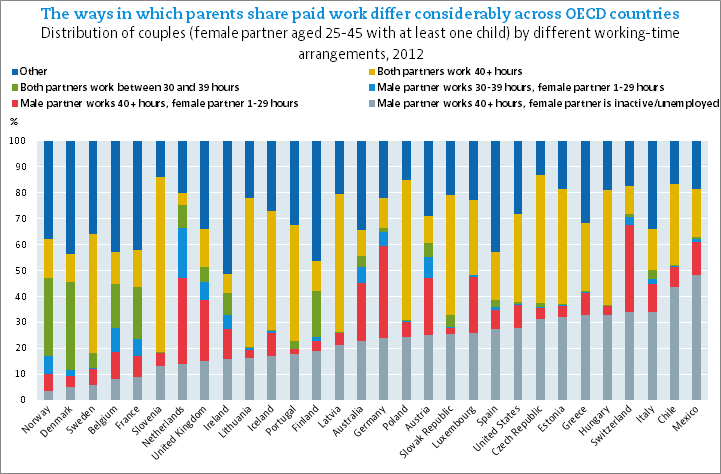How do partners in couple families share paid work?
March 2017 - The dramatic increase in the number of women and mothers in the workforce in recent decades has led to large shifts in the way partners in couple families share and organise paid work. In many OECD countries, the dominance of the traditional male-breadwinner model is now largely a thing of the past. In most countries, fewer than one in three couples with at least one child have a father who works 40 or more hours per week and a mother who is not in paid work, and in Belgium, Denmark, France, Norway and Sweden, this falls to below one in ten couple families. Among OECD countries with comparable data, only in Mexico and to a slightly lesser extent Chile does the male-breadwinner model remain the main work arrangement for couples with children.
Yet, while “dual-earning” is now the norm across much of the OECD, there are still considerable differences between countries in the ways in which couples share paid work. In some countries, a “one-and-a-half-earner” model prevails with one parent (usually the father) working full-time and the other (often the mother) working part-time. In Germany, for instance, more than one-third of all couples with children have a father in paid work for 40 or more hours per week and a mother in paid work for fewer than 30 hours per week. This arrangement is also common in the other German-speaking OECD countries (Austria and Switzerland), as well as Australia, Luxembourg, the Netherlands and the United Kingdom.
In other OECD countries, it is more common to find both parents working full-time. Often, this means long hours equal to or greater than 40 hours per week for both fathers and mothers, as in Eastern Europe, Iceland, Portugal, Sweden and the Baltic countries. In Belgium, Denmark, Finland, France and Norway, “full-time dual-earning” often means that both parents are in paid work for between 30 and 39 hours per week.
|
|
|
Note: Usual weekly working hours of the employed for European countries, Australia and the United States, and actual hours worked for Chile and Mexico. Data refer to total hours worked in all jobs, except for Chile where only hours worked in the main job are considered. “Inactive/unemployed” based on self-declared labour market status. 'Other' working-time arrangements include those where both partners are inactive/unemployed, those where the male partner works 1-29 hours and the female is either inactive/unemployed or works 1-29, 30-39 or 40+ hours, those where the male partner works 30-39 hours and the female partner is either inactive/unemployed or works 40+ hours, and those where the male partner works 40+ hours and the female partner 30-39 hours. |
Related Documents


